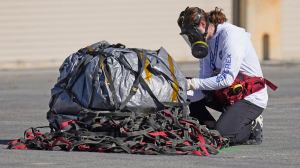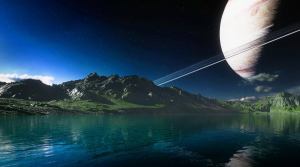Scientists have spotted what they are calling a “space hurricane” over the North Pole. According to a new study in the journal Nature Communications, this is the first time a phenomenon of this kind has been observed in real life. However, scientists had previously speculated that it could be a reality.
The “space hurricane” is a 600-mile-wide mass of plasma hanging hundreds of miles above the earth, near the North Pole. A study of the storm was published by a team of astronomers including Mike Lockwood of the University of Reading. In a public statement on Wednesday, he wrote: “Until now, it was uncertain that space plasma hurricanes even existed, so to prove this with such a striking observation is incredible.”
Videos by PopCulture.com
“Tropical storms are associated with huge amounts of energy, and these space hurricanes must be created by unusually large and rapid transfer of solar wind energy and charged particles into the Earth’s upper atmosphere,” Lockwood explained. Lockwood and other researchers are now speculating that “space hurricanes” of this sort may be a common phenomenon throughout the universe. He said: “Plasma and magnetic fields in the atmosphere of planets exist throughout the universe, so the findings suggest space hurricanes should be a widespread phenomena.”
Scientists from Shandong University in China detected the space hurricane using data first drawn from satellites in August of 2014. This week, scientists unveiled a 3-D image of the storm created using computers. The co-authors of the study say that it sheds “new light on the relationship between planets and space.”
“There are tens of space hurricane events from the satellite, which has already been identified by our team, and I think there are more cases in the future and in the dataset that we didn’t finish,” added Qing-He Zhang of Shandong University, in an email to reporters from Vice. “I think there will be more teams from Europe, US, Canada, Japan and China, etc., who will do more research on space hurricanes in the future.”
The comparison to earthly hurricanes is apt since real hurricanes occur when warm, moist air rises in Earth’s lower atmosphere, creating an area of low pressure near the surface that sucks the surrounding air in. Instead of heavy rain, the space hurricane causes a shower of electrons.
Practically speaking, scientists say that a “storm” like this could impair GPS systems and other space-based infrastructure, so it is well worth studying. However, they warned of no immediate dangers posed by this phenomenon. More research in this area is expected to begin immediately.
Related Posts
-

A recovery team member examines a space capsule carrying NASA's first asteroid samples on September 24, 2023 to a temporary clean room at Dugway Proving Ground in Utah. A seven-year space voyage came to its climactic end Sunday when a NASA capsule landed in the desert in the US state of Utah, carrying to Earth the largest asteroid samples ever collected. Scientists hope the asteroid sample aboard the spacecraft will provide humanity with a better understanding on the formation of our solar system and how Earth became habitable. (Photo by Rick Bowmer / POOL / AFP) (Photo by RICK BOWMER/POOL/AFP via Getty Images)




